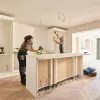How To Get a Cash-Out Refinance After a Renovation

If you’ve recently renovated your house, it has probably shot up in value. But you may also have repair bills to pay off or have drained your savings.
Can you do a cash-out refinance after a renovation to pay off debt or reimburse yourself?
Yes. Lenders allow you to pull cash out of the home based on the new value. You open a bigger loan than your current mortgage and receive the difference in cash.
How a Cash-Out Refinance after Renovation Works
Here’s a snapshot of how this process works.
Start with an unrenovated home
Plan renovations
Pay for renovations on credit or with cash
Complete renovations
Apply for the cash-out refinance (loan is based on estimated new value)
The lender orders an appraisal, verifies estimated value
Adjust loan amount based on actual appraised value, if needed
Close the loan
Proceeds are wired to you (new loan minus current mortgage and any debts paid off)
Use proceeds to pay off debt or reimburse renovation costs
Here’s an example of how this might look with dollar values.
Current Mortgage | $200,000 |
Renovation Costs | $50,000 |
Closing Costs | $7,000 |
Total | $257,000 |
New Loan Needed | $257,000 |
New Value Required | $322,000 |
The maximum cash-out refinance loan-to-value (LTV) is 80%. In the above example, the new home value would need to be about $322,000.
Cash-Out Refinance Uses After Renovation
A cash-out refinance can come be quite useful after you renovate a home:
Pay off debts incurred during the renovation
Pay down or pay off HELOCs or home equity loans
Reimburse cash spent on the renovation
Pull out home equity to finance other projects
Reduce your rate on the first mortgage
You can accomplish one or many of the above goals with one refinance. If mortgage rates have dropped since you last purchased or refinanced, it’s an even better time to consider this strategy.
Maximum Cash-Out LTV and Loan Amounts
For a 1-unit primary home, you can pull out up to 80% of your home’s new value with a cash-out refinance. Following are other maximum LTV limits.
Cash-Out LTV Limits for Conventional Loans | ||
Home use | 1 unit | 2-4 unit |
Primary home | 80% | 75% |
Second home | 75% | ineligible |
Investment property | 75% | 70% |
Your maximum loan will depend on:
The new appraisal
What you qualify for
Local loan limits
New appraisal: After you apply, the lender will order an appraisal. Your new loan maximum is based on whatever value comes back. You don't have to borrow this much, however.
Qualification: You also must qualify for the new loan. You can have a maximum 45% debt-to-income ratio. The new loan payment plus all other monthly debts can be no more than 45% of your gross income. You can pay off debts to qualify, including those incurred for the renovation.
Local loan limits: Up to the standard conventional loan limit. Look up your loan limit here.
Waiting Periods
Be aware of cash-out refinance waiting periods, especially if you recently purchased the home.
Six-Month Ownership Waiting Period
If you recently acquired the house, or you were recently put on title, this waiting period could affect you.
At least one borrower must be on title for six months by the time the new refinance closes.
So if you purchased a property on January 1, for example, you could apply for a cash-out refinance any time, but it couldn’t close until July 1.
Exceptions:
The property was an inheritance
You are reimbursing yourself for a 100% cash property purchase
The property was owned by an LLC or trust primarily controlled by a borrower on the loan
12-Month Mortgage Payoff Waiting Period
The underlying mortgage being paid off must be 12 months old when the loan closes.
If you purchased the home with a mortgage eight months ago, you would need to wait another four months to close the cash-out refinance.
This rule does not apply to home equity lines or loans, or other liens acquired during the renovation.
Can I Refinance Before or During Renovation?
You can refinance before or after a renovation, but attempting to do so during construction can be problematic. Here’s what to think about in both scenarios.
Before Construction
To pull cash out before renovations, you need substantial equity in the home already without considering upgrades.
You would need enough equity to pay off the existing mortgage plus pay for the renovation. For example, the home is worth $400,000 as-is and you owe $200,000. You could get a cash-out refinance for $300,000 and have nearly $100,000 for the remodel.
The lender won’t factor in future renovations in loan-to-value calculations. The better option would be a renovation refinance to pay off the existing loan plus finance renovation costs.
During Construction
The lender won’t be able to close a standard loan while the home is under construction. The repairs would have to be completed prior to close.
However, you could refinance using programs like Fannie Mae HomeStyle, Freddie Mac CHOICERenovation, or FHA 203k. You would finance repair costs into the loan. The new loan would be based on the as-completed value as estimated by the appraiser.
Alternatives to a Cash-Out Refinance after Renovation
A cash-out loan isn’t always the best move, especially if you currently have a low rate or you just need a small amount of cash.
A cash-out refinances come with higher rates than purchase mortgages and rates may have risen since you purchased. Closing costs are between $5,000 and $10,000 for most loan amounts.
A HELOC or personal loan could be a better option, giving you quick cash with little to no closing costs. And, you don’t have to touch your first mortgage.
How to Apply for a Post-Renovation Refinance
Any mortgage lender can walk you through the cash-out refinance process. All lenders generally follow the same rules: ones outlined by Fannie Mae and Freddie Mac.
Apply with a lender for a cash-out refinance on your newly remodeled home.






